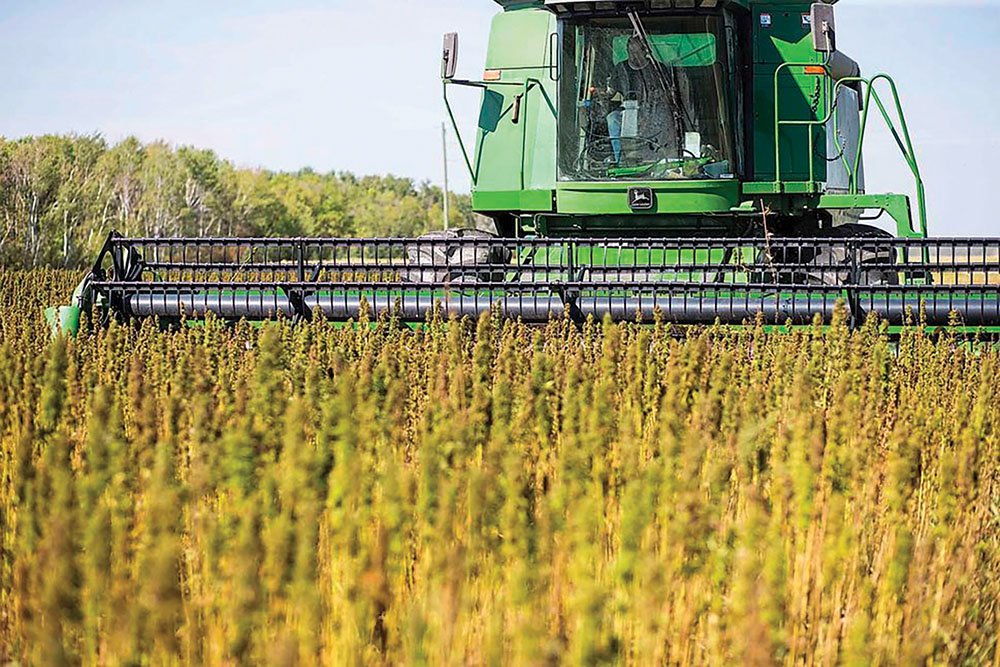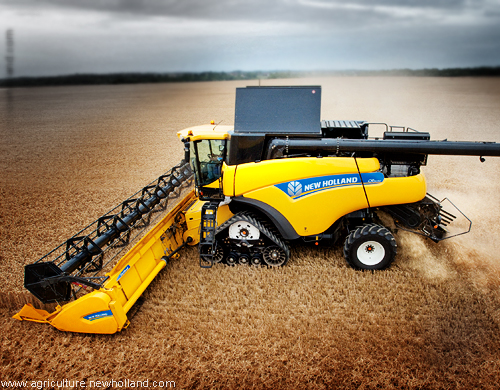Hemp Harvest Equipment
Harvest method and equipment should be an early consideration when deciding to grow a hemp crop.
Hemp grain harvesting is generally done by straight combining however swathing is occasionally utilized.
The newer models of combines are best suited to handling the hemp harvest and require minimal modifications. These machines have bigger cylinders and cleaning area. Headers can be operated at higher levels so all stands of hemp can be accommodated.
Most new combines are now rotary design. Some new machines have the swath entering at the bottom of the cylinder. On earlier machines, the swath would hit the middle of the rotor after leaving the feeder housing. The rotor then had to direct the material up the side of the rotor. This slight hesitation would be enough to allow the hemp to wrap on the front bearing of the rotor. The product flow is smoother in new machines. The draper header is preferred by growers. They have more clearance to allow the hemp stalks to lay down on the canvas. This promotes a more even feed of the material into the combine. Some growers have had success with conventional headers as well.

Conventional Auger Header

Draper Header
Video of the Case IH combining Hemp with conventional header.
Combine Settings
Settings need to be adjusted according to individual crop moisture and general conditions. Adjustments need to be made as the harvesting continues. Producers have found that canola, peas or bean settings for the cylinder and concave are a useful starting point for combining hemp. The air, sieve and chaffer are set similar to wheat, for a starting point.
Proper setting of the combine improves the yield and quality of the grain and reduces wear on the combine. Experiment with ground speed, concave openings, air speed etc.
Following is a suggested starting point to set a combine for harvesting of hemp.
- Cylinder Speed – 450-600rpm
- Concave- 30-50mm
- Wind- 1070 rpm
- Sieve- 3mm
- Chaffer- 10mm


Swathing
Swathing of hemp is not a common practice, but it does have its place in some circumstances. Consider swathing for the following:
- Hemp production in arid locations i.e. Southern Alberta
- Areas of high winds to reduce plants rubbing each other causing shelling.
- Short varieties.
- To reduce aeration or drying requirements.
If swathing:
- Pick a window when there will not be rain.
- Swath and leave for 2 to 4 days to dry down. Combine before it is too dry. If the stems are too dry, the fibers in the stalk shatter and separate, causing fine fibers to wrap on bearings, chains, etc.
- Do not swath if rain is expected or if the soil surface is staying wet.
- If conditions are wet, hemp will sprout very quickly in the head and especially on the bottom of a swath.
- Seed in contact with the ground may develop mold, bacterial development and coliform contamination causing quality loss and downgrading of seed.
- Be aware seed contamination can occur from small stones, dirt, manure and other foreign material.
- Remember standing hemp will dry faster in damp conditions than swathed hemp
John Deere Rotary
- Initial settings – cylinder 530 rpm, concave setting at 6, air 750 rpm, top sieve 18, bottom sieve 6
- Use the cylinder at the slower speed on the high-speed setting.
- As the crop gets dryer, slow rotor and open concave.
- Shield drive shaft going from planetary
- Put a pan over the grate on the discharge beater. Speed up the beater – double the speed. Specialty discharge beater – remove or run at a higher speed.
- Bolt belting on the discharge beater lugs to eliminate wrapping on the shaft and bearings on the beater. Do the same on the front accelerator.
- Use the wide wire concave. Do it by pulling every second wire in the concave. This will result in less plugging.
- Bypass the chopper
- Regularly check the top and bottom rotor bearings for wrapping.
Case IH
- Cylinder 600 rpm
- Concave setting 14
- Sieve same as wheat, close front one slightly
- Wind – check sample increase if too much plant material and trash is in the hopper.
- Regularly check the top and bottom rotor bearings for wrapping.

Lexion Claas 4000
- Sieves setting 13 and 7, set fan like canola 1000 rpm
- Concave as wide as possible. Start at setting 20. Tighten concave before speeding up the cylinder.
- Set cylinder at 450 to 700 rpm.
- Every year is different.
New Holland
Some New Holland models have a rear beater similar to the John Deere. Some have spikes on this beater to help discharge the straw. It is suggested to remove these spikes as the hemp straw will wind around the beater under some conditions.


